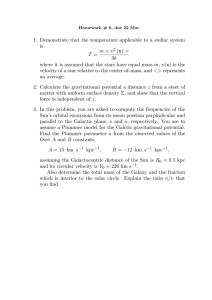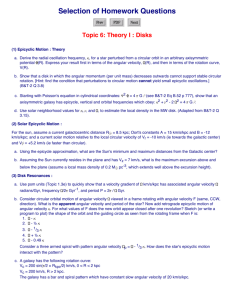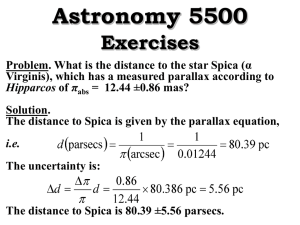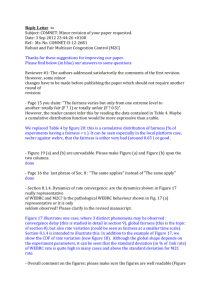PC2491 Examples 2
advertisement
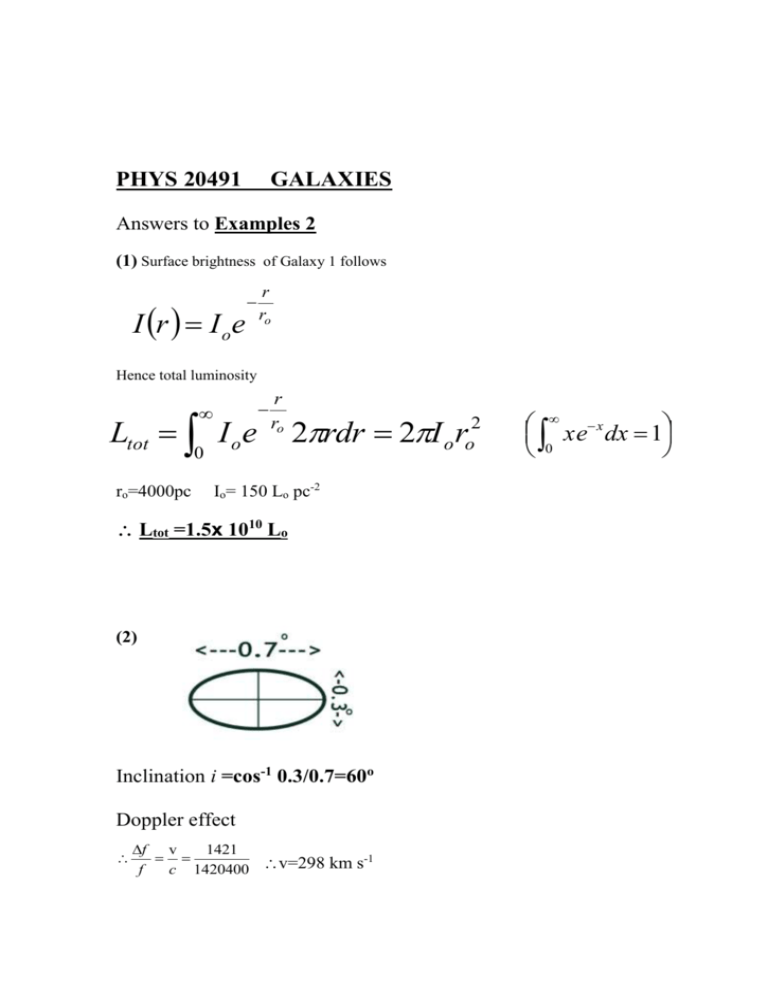
PHYS 20491 GALAXIES Answers to Examples 2 (1) Surface brightness of Galaxy 1 follows I r I o e r ro Hence total luminosity Ltot I o e r ro 0 ro=4000pc 2rdr 2I r Io= 150 Lo pc-2 Ltot =1.5x 1010 Lo (2) Inclination i =cos-1 0.3/0.7=60o Doppler effect f v 1421 -1 f c 1420400 v=298 km s 2 o o xe x dx 1 0 Circular velocity is inclined to line of sight Vr Vcirc sin i cos Velocity is measured on major axis cos 298 / 2 Hence V 172 km s 1 circ cos 60 Radius of galaxy r r ~ 3000 tan(0.25o) =13.1 kpc Assume keplerian rv 2 13.1 3 109 172 103 M G 6.67 1011 2 1.78 1041 kg M=9x 1010 Mo (3) Resolving components of velocity along LS Vradial V (r ). cos o Ro sin l Vr r .r. cos o Ro sin l From triangles Ro sin l r sin 90 r cos Radial Vr r o Ro sin l Velocity Consider H1 cloud at l=30o with Vr=80km/s V vr Vr 80 220 o r Ro sin l Ro 8.2 sin 30 8.2 46.3 km/sec/kpc Hence r = 220/46.3= 4.7 kpc Hence using cosine law r 2 Ro2 d 2 2 Ro d cos l d 2 Ro cos l 4R d= 4.8 & 9.4 kpc (4) Mean Free Path Stars interact if Gm2 1 PE KE 2 mv 2 d 2Gm ie d 2 v 2 o cos 2 l 4 Ro2 4r 2 2 If star density is n, interaction will occur in cylinder radius d if star travels distance mean free path 1 v4 2 2 2 d n 4G m n n= 1 star pc-3 = (3x1016)-3 = 3.4x10-50 stars m-3 10 10004 4 6.67 10 = 44 Mpc [Alternative 2 10 11 2 30 2 3.4 10 50 1.3 10 24 m work out relaxation time v3 100003 tc 4nG 2 m 2 4 3.4 10 50 6.67 10 11 2 2 1030 2 1.3 10 20 sec Hence mean free path ~ velocity x relaxation time = 1.3 x 1024 m] H1 atoms Atoms interact if d=2r 1 1 3.2 109 m 2 2 d n 10 8 106 =10-7 pc (5) for a flat rotation curve dv 0 dr Ro V V A 12 o & B 12 o Ro Ro Hence if Vo= 180 km s-1 and Ro = 3kpc A= 30 km s-1 kpc-1 and B = -30 km s-1 kpc-1 2 r 2 2 1 Epicyclic frequency Now v r dv d r d r dr dr dr & v r v r 2 2 1 r v r 2 2 v r 2 2 r r 2 r dv but 0 dr Ro 2 2 Hence 3kpc 2 180 84.8 km s -1 kpc 1 3 At Inner Lindblad Resonance for two armed spiral P r P 2 180 84.8 17.6 km s -1 kpc -1 3 2 Corotation is when ie 17.6 P r 180 r Hence corotation radius is at 10.2 kpc (6) for collapse Gravitational PE > KE GM 2 1 M v2 R 2 Now 1 3 m p v 2 kT 2 2 4 3 & M R 3 Where mp is mass of proton R2 Hence substituting 9kT 4m p G 1 2 1 2 kT 1.38 10 100 2.7pc R 27 2 9 11 m G 10 6.67 10 p 1.67 10 23 (7) Unlike spirals, elliptical galaxies have no Neutral Hydrogen which is the main tracer of spiral galaxy dynamics, particularly at large radii. Also ellipticals have no O & B stars which means there are no HII regions and hence H etc emission. Hence the elliptical dynamics have to be determined from stellar absorption spectra, but as there are no young stars these lines are weak. Also as ellipticals are 3-D objects (unlike spirals which are ~2-D) the line profiles are blended by a range of lines at different depths at differing distances from the centre of the galaxy. The main observational result of these studies is that Massive ellipticals show low rotation velocities (V)~ 50 km/s, but high velocity dispersion ~2-300 km/s. By comparing their V/ ratio it appears that flattened Ellipticals (eg E5-E7) are not supported by rotation. The other major result from these studies is that the luminosity and stellar dispersions are linked via the Faber-Jackson relation L 4 (8) Elliptical galaxies can be described by the 3 parameters Re, e and o , where Re is the half light radius, e is the mean surface brightness within Re, and o is the central velocity dispersion. It is found empirically that they are related by Re o1.4 e0.85 Hence if these parameters are plotted along 3 perpendicular axes, samples of elliptical galaxies will lie on a plane defined by the above equatiom. This is known as the ‘fundamental plane’ for elliptical galaxies. The luminosity –dispersion relation L shows a scatter of 12 magnitudes and hence while it can give an estimate of distance, there are large errors. 4 However by plotting Re vs 1.4 e-0.85 a plot with typically a few tenths of a magnitude scatter can be obtained, and hence significantly more accurate distance estimates. Origin of relationship The average surface brightness e within Re is given by e L/2 Re2 Also the potential energy must be comparable to the kinetic energy if the galaxy is not to expand or collapse. GM k 02 Re Where k is a ‘structure parameter’ containing information on the elliptical galaxy Hence combining both equations 1 Re k M 2 1 o e 2G L 1 M 2 1 Re k o e L Show this is consistent with the ‘Fundamental Plane’ M k L0.25 0e .25 Re0.5 L 1 as L e Re2 1 M substituti ng into RHS of Re k o2 e1 L hence Re1.5 e1.25 o2 Re e 1.25 1.5 2 1.5 o e0.83 o1.33 ie approximately consistent with the ‘fundamental plane’ Re e0.85 o1.4 (9) Distance of LMC from Galactic Centre = 50 kpc, rotational velocity =200 km/s Hence mass of galaxy within 50kpc M 2 V 2 R 200 10 3 50 3 1019 M 9 10 41 kg 4.5 1011 M o 11 G 6.67 10 Assume it is a point mass, hence from notes 1 3 1 3 2M m R r r R m 2 M 1 3 1010 m 50 11.1 kpc r R 11 2 M 2 4 . 5 10 Hence So stars & gas will be strongly tidally by Milky Way if they are > 11kpc from the centre of the LMC. (10) Using the Virial Theorem 2T+=0 T 1 1 2 m v M v2 i i 2 i 2 Gmi m j rij j i i M Hence GM 2 R R v2 G GM 6.67 1011 1014 2 1030 11 v 1 . 5 10 R 3 3 1022 2 hence v 1 2 2 1.5 1011 3.8 105 m s 1 380 km s 1
